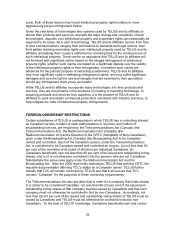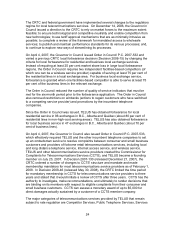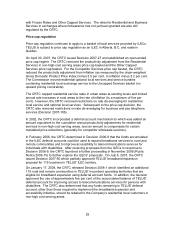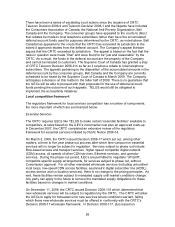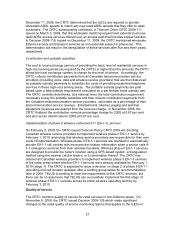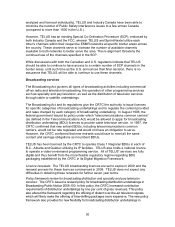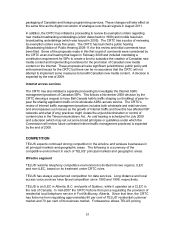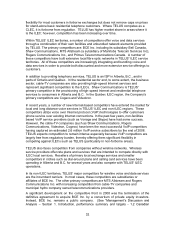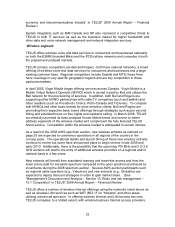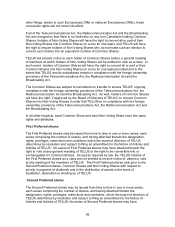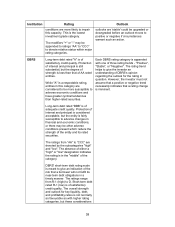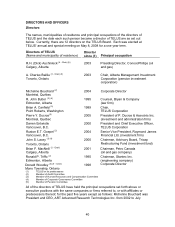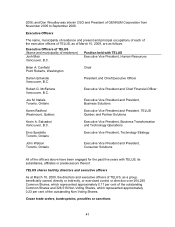Telus 2008 Annual Report Download - page 31
Download and view the complete annual report
Please find page 31 of the 2008 Telus annual report below. You can navigate through the pages in the report by either clicking on the pages listed below, or by using the keyword search tool below to find specific information within the annual report.packaging of Canadian and foreign programming services. These changes will take effect at
the same time as the digital conversion of analogue over-the-air signals in August 2011.
In addition, the CRTC has initiated a proceeding to review its exemption orders regarding
new media broadcasting undertakings (which dates back to 1999) and mobile television
broadcasting undertakings (which was issued in 2005). The CRTC has a policy of reviewing
its exemption orders every five years. The CRTC has launched a public hearing
(Broadcasting Notice of Public Hearing 2008-11) for this review and initial comments have
been filed. Some of the proposals made in this first round of comments were considered by
the CRTC at an oral hearing that began in February 2009 and included mandating a
contribution requirement for ISPs to create a fund to subsidize the creation of Canadian new
media content and implementing incentives for the promotion of Canadian new media
content on the Internet. These proposals all raise significant jurisdictional, public policy and
enforcement issues for the CRTC but there can be no assurance that the CRTC will not
attempt to implement some measures to benefit Canadian new media content. A decision is
expected by the end of 2009.
Internet access services
The CRTC has also initiated a separate proceeding to investigate the Internet traffic
management practices of Canadian ISPs. This follows a November 2008 decision by the
CRTC denying a request to have Bell Canada halt its traffic shaping (or throttling) of peer-to-
peer file sharing application traffic on its wholesale ADSL access service. The CRTC’s
review of Internet traffic management practices includes both wholesale and retail services
and encompasses such issues as the growth of Internet traffic and how this has affected ISP
networks and what (if any) practices might violate the unjust discrimination or control of
content rules in the Telecommunications Act. An oral hearing is scheduled for July 2009
and a decision (which may set out some broad principles or guidelines under which the
Commission will review future contested Internet traffic management practices) is expected
by the end of 2009.
COMPETITION
TELUS expects continued strong competition in the wireline and wireless businesses in
all principal markets and geographic areas. The following is a summary of the
competitive environment in each of TELUS’ principal markets and geographic areas.
Wireline segment
TELUS’ wireline telephony competitive environment is divided into two regions, ILEC
and non-ILEC, based on its treatment under CRTC rules.
TELUS has always experienced competition for data services. Long distance and local
access voice services have faced competition since 1993 and 1998, respectively.
TELUS is an ILEC in Alberta, B.C. and parts of Québec, while it operates as a CLEC in
the rest of Canada. In mid-2007 the CRTC forbore from price regulating the provision of
residential local telephone service in Fort McMurray, Alberta. Since that time, the CRTC
has forborne from regulating approximately 80 per cent of TELUS’ residential customer
market and 70 per cent of its business market. Forbearance allows TELUS pricing
31



